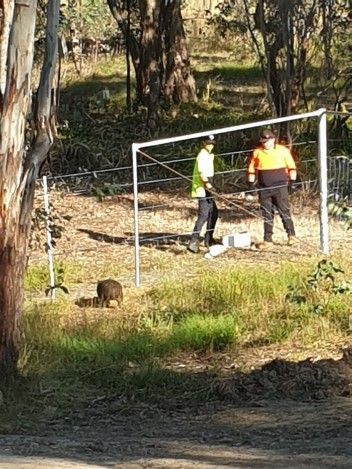Ranger Chris Allen reflects on working with volunteers to deliver bushfire recovery projects with Parklands…
In the past 12 months Parklands have welcomed volunteers from Charles Sturt University, Wodonga Senior Secondary College, Department of Defence, and many kind individuals who found us through word of mouth, social media, our newsletter or website. With the gift of their time and energy, these wonderful volunteers have ensured local projects under the Victorian Landcare Led Bushfire Recovery (LLBR) program have been implemented with lasting benefits for our region.
Parklands were fortunate to be successful with two large-scale LLBR projects, with a range of components including nestbox programs, fencing and invasive weed management.
Nest Box Installation and Monitoring
Delivering the Nest box component of Parklands LLBR projects, volunteers learnt a range of skills throughout the process. Tom from Wodonga Senior Secondary, Michael and Brad all helped during the installation phase, learning how suitable trees are identified, installation practices and safe work procedures for working at heights.
Parklands also completed the monitoring of 200 nest boxes. Students from WSSC along with Oscar and Michael E. were involved in checking these boxes across a range of sites, learning about species that use the nest boxes, how to tell a Sugar glider from a Squirrel glider and about data collection processes for the threatened Squirrel glider.
Exclusion Fencing
A large part of Parklands LLBR projects has been fencing sections of Box Gum Grassy Woodlands to remove livestock from these sensitive areas. Volunteers have helped with every aspect of installation. Michael E, along with students Michael W, Tom and Juda helped in setting strainer posts across our project sites at McFarlane’s Hill, Swainsona Reserve and various river sites along the Murray.
Brad, Craig, Michael E, along with all the WSSC students all had a go at installing star pickets with the mechanical driver and running wires, learning the termination and joining knots used in fencing.
Weeding
Our LLBR projects have included several weed infested sites in our region. Each site had unique issues and challenges such as Grays Island where we had to canoe to access the site. Volunteers spent time on various sites managing a range of weeds including broad and narrow leaf Privet, Tree of Heaven, Olives, Box Elder, Hawthorn, Briar Rose, Blackberries, False Acacia, Cherry plum. They learnt how to identify these common weed species, how they spread, the impact they have on our native species, and the best method for control.
Michael E finishing up after a long day cutting and poisoning False Acacia at Baranduda.
Volunteer Cara’s photo of our transport to and from Grays Island
Volunteers have also been instrumental in achieving other goals including helping during Parklands depot move, installing new pedestrian bridges, removing fences and rubbish collection to name a few.
We would like to extend a heartfelt thank you to everyone who has pitched in during the past 12 months to deliver restoration and conservation outcomes in the regional parks and help ensure the broader community can access and enjoy nature in our region.
Thank you to Michael E, Cara, Brad, and Steve – wonderful volunteers who contacted us to volunteer some of their time to help. Thank you to the Charles Sturt University volunteers Gavin, Oscar, Megan, Harrison, and Craig. And finally thank you to Wodonga Senior Secondary College’s Fiona for organising the student volunteers who have help tremendously, Tom, Juda, Ethan, Michael W, Conner, Imogen, and Aidan.









